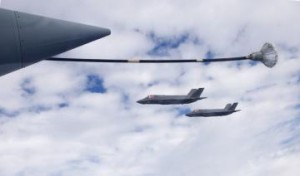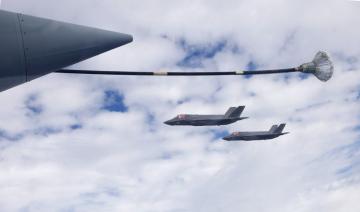2013-01-03 The Canadians have an aging tanker fleet.
They have refreshed the fleet with the addition of 2 Airbus MRTT tankers, which they bought at roughly the same time as did Germany.
The Airbus A310 Multi Role Tanker Transport (MRTT) is based on the A310 airframe and the Germans along with the Canadians have bought 6, with the Canadians having two which they designate as the CC-150 Polaris. As with all tankers, the commercial airframe provides a baseline from which a tanker is then built. It is clearly not simply an update of a commercial aircraft. No one would ask of a commercial aircraft what one would ask of a military tanker!
For the Canadians, the two CC-150 Polaris tankers allow them to deploy fighter aircraft at a distance. The aging C-130 tankers provide tactical re-fueling but overall the Canadians can not provide tanker support to either their 4 C-17s or to their projected new F-35s.
http://www.youtube.com/watch?v=LRi9dsCvU1I
Amazingly in the Canadian discussions about F-35, this is has become a “problem,” because it is asserted that no extant Canadian tanker can tank the F-35A.
Of course, Canada does not currently have the F-35 and by the time they might, they should have a new tanker that does USAF style tanking with a boom and receptacle system and they then can tank both their C-17s as well as their projected F-35s.
In a recent Canadian article it was asserted that the tanker infrastructure would be unable to support the F-35s, although no mention of the failure to support the C-17 was made.
This was in the context of the amazing “audit” of the cost of the F-35 42 years into the future. One could easily ask how an auditing firm claims professionally an aircraft, which has only begun to be deployed, but that is amazing in and of itself.
“With respect to air-to-air refueling requirements, DND will rely on (the U.S.), coalition partners, or commercial refuelling assets to meet operational requirements,” reads KPMG’s final report, which was released last week.”
http://www2.canada.com/theprovince/news/story.html?id=deb189c2-8b8f-48ce-af37-60f8ff9d48bf
If this reflects the quality of the report overall, Canada is in trouble.
We might note as an aside that the F-35B already does probe and drogue refueling.
http://www.youtube.com/watch?v=7xR_3H0qaTE
Let us provide a bit of analysis on this problem.
First, Canada is to receive new tankers which will be able to do both boom/receptacle and probe/drogue refueling.
Second, if Canada for some reason decides not to get new tankers (a decision that would need to be looked at in and of itself), Canada could modify existing tankers to do boom refueling. This is not rocket science but a straightforward modification.
The F-35A has room to add a probe (for probe/drogue refueling) but Canada could choose to modify its tankers instead or to add new ones.
The CC-150 aircraft have been modified with baskets for probe and drogue refueling of the CF-18s for higher altitude long range ferries. It does not currently have a boom for receptacle refueling.
The RCAF has investigated adding a boom to the CC-150 instead of adding the probe to the F-35A. It was a fraction of the cost of the fighter mod.
Modification of the F-35A would provide two methods of aerial refueling but would diverge from the commonality of 2500+ worldwide fleet of CTOL variants thereby reducing the benefits of the economies of scale through-life.
And as a bonus then the CC-150s would then be able to tank the CC-17s,
The KC-130s will be out of service life when CF-18s are fully replaced with CF-35s and these new aircraft will bring greater fuel capacity and range than the F-18s they are replacing. This means that little domestic tanking will be required.
Finally, most NORAD tanking support for CF-18s today are done with KC-135s with a basket attached to the boom.
In short, context is everything.
If you take the F-35 out of a 21st century context and assert the viability of aging aircraft inventories you really miss the point.
And for the auditors it would be interesting to determine really the support cost of F-18s 42 years in the future.
In my discussions with NAVAIR, senior officials know full well that it is very difficult to determine the cost of taking the aging F-18 Cs forward into the next decade for an airframe that should go no more than 6,000 hours and now is supposed to do 10,000. And as one official told me flat out: “There is no comparison between the sustainment costs of getting to 6,000 hours to going from 6 to 10,000.”

Remember the 55 year projection of F-35 costs from the cost minders? Instead of laughing this off the analytical stage, this nonsense still shows up.
But as I wrote earlier, this is like doing cost projections from 1957 to 2012.
Recently, we have seen yet again, a US government report on the life cycle costs of the F-35 fleet from a 55 year perspective!
One could ask a simple question: what has mandated this question and why are they not fired?
There are many questions one can ask in life but wondering about the lifecycle costs of combat systems 55 years in the future is not one of them.
There can only be one purpose of posing this question: to come up with a PR number to club the program.
But analytically, we should laugh this effort off of the stage. Simply to pose the question should be met with ridicule, disdain or perhaps sorrow.
To give perspective, let us imagine that our predecessors had been so stupid or irrelevant. Let us go back in time – 55 years ago – and pretend that we are GAO analysts being tasked to look at the life cycle costs of weapon systems by the year 2012. (Hard to imagine President Eisenhower not calling such folks up to the White House for a barbecue, and not to eat ribs)….
So we might start this way.
We are not comfortable with the open-ended commitment of US forces in Germany to deter the Soviet Union. What will be the costs of such a commitment through 2012.
What are the projected costs for US forces in Germany in 2012 seen from 1957? We estimate that the annual costs in 2012 dollars will be x trillions of dollars, and the uncertain nature of deterrence might well be called into question and the very open ended Eisenhower doctrine might be used by the Administration to justify even higher expenditures OUTSIDE of Europe.
Weapon systems have been developed to provide for deterrence in Europe, like the F-100 that provide sufficient deterrence to the Soviet Air Force, which in our estimate is not of the same quality or capability of the US and European Air Forces.
We see little justification for developing an untested aircraft, the F-4, whose early developmental problems and costs call into question the need for this aircraft.
We think testing should stop until the program can be demonstrated to be technologically mature and ready for deployment. Testing is dangerous and until all uncertainty can be driven out of the program, we think the testing should cease and desist.
We also are concerned that this advanced weapon system will only be used by US forces which in turn further drive up the costs of the weapon system.
Our forcecast for the F-4 fleet through 2012 – a fleet of probably 800 aircraft – would be over the 55 year forecast to be nearly (you make it up) x dollars.
We are also concerned with the costs of nuclear warheads to be deployed by the US Army with the Redstone arsenal. The Eisenhower Administration is increasingly relying on nuclear weapons to provide for deterrence and the costs of the development, deployment and maintenance of these weapons has not been fully clarified. Until clarification is provided to the Congress and the GAO, we think the Eisenhower Administration policy should be slowed down to permit proper oversight.
And the development of the new Jupiter missile as well provides a significant uncertainty over the costs of deploying a new system of nuclear deterrence.
By combing a projected Redstone with Jupiter arsenal, fully configured for combat, we would project over 55 years – including life cycle costs – that a European based nuclear combat force would cost ((you make it up) x dollars.
https://sldinfo.com/the-1957-perspective-on-the-2012-us-military/
Well I will stop for now. It is hard to have so much fun.


